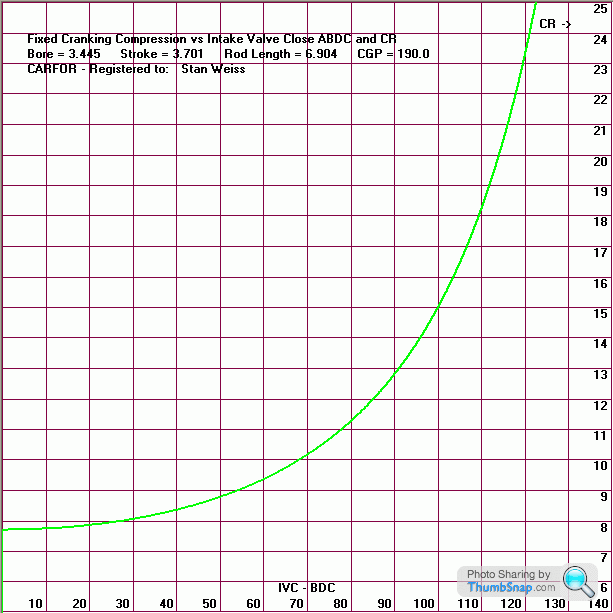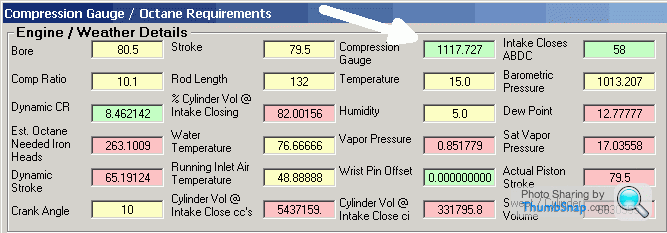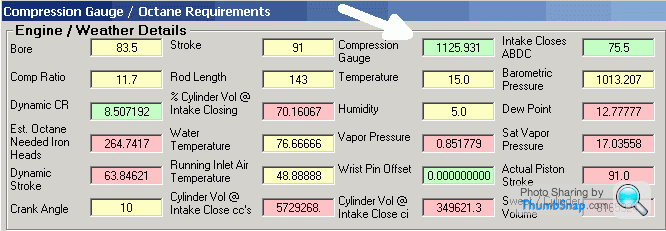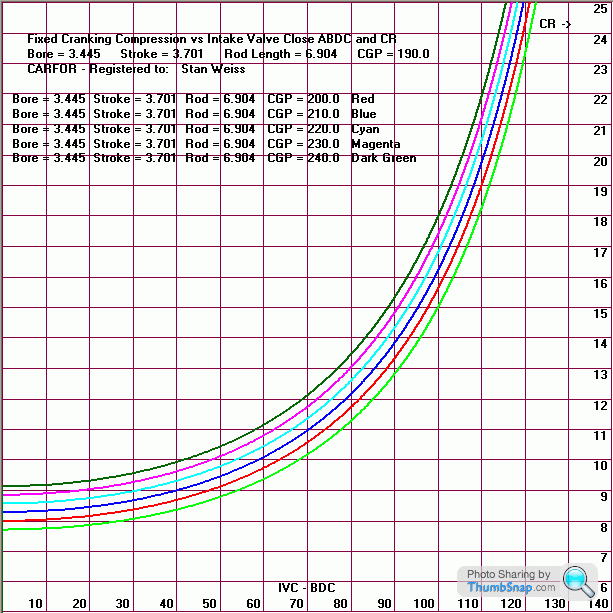Compression ratio, DCR, cam duration, cast pistons, etc
Discussion
I'm posting this seperately from Puma Racings cranking pressure thread as I did not want to dilute the thread.
I am a hobbiest, have built a few engines, some more than once as I learn more and correct mistakes.
I read a lot and have a surface understanding of the relationship between compression ratio, cam duration, DCR & cranking pressure
Where I fall down is when static compression ratio is quoted as a maximum ( usually 10.5 to 1 for cast Pistons) and yet compression is down due to cam duration.
I do understand that when an engine comes on cam the pressures increase
But I still can't get my head around static compression ratio and cranking compression pressure.
Would all my problems disapear if I just fitted forged Pistons?
All my work so far has been with Pinto's however I'm soon to start on Duratec
I am a hobbiest, have built a few engines, some more than once as I learn more and correct mistakes.
I read a lot and have a surface understanding of the relationship between compression ratio, cam duration, DCR & cranking pressure
Where I fall down is when static compression ratio is quoted as a maximum ( usually 10.5 to 1 for cast Pistons) and yet compression is down due to cam duration.
I do understand that when an engine comes on cam the pressures increase
But I still can't get my head around static compression ratio and cranking compression pressure.
Would all my problems disapear if I just fitted forged Pistons?
All my work so far has been with Pinto's however I'm soon to start on Duratec
PaulKemp said:
I'm posting this seperately from Puma Racings cranking pressure thread as I did not want to dilute the thread.
I am a hobbiest, have built a few engines, some more than once as I learn more and correct mistakes.
I read a lot and have a surface understanding of the relationship between compression ratio, cam duration, DCR & cranking pressure
Where I fall down is when static compression ratio is quoted as a maximum ( usually 10.5 to 1 for cast Pistons) and yet compression is down due to cam duration.
I do understand that when an engine comes on cam the pressures increase
But I still can't get my head around static compression ratio and cranking compression pressure.
Would all my problems disapear if I just fitted forged Pistons?
All my work so far has been with Pinto's however I'm soon to start on Duratec
I think that it depends on the cast pistons. I maybe showing my age but back when forged pistons were a very expensive / limited option I and many others ran after market cast pistons with much higher CR's. Mine would have been in a SBC.I am a hobbiest, have built a few engines, some more than once as I learn more and correct mistakes.
I read a lot and have a surface understanding of the relationship between compression ratio, cam duration, DCR & cranking pressure
Where I fall down is when static compression ratio is quoted as a maximum ( usually 10.5 to 1 for cast Pistons) and yet compression is down due to cam duration.
I do understand that when an engine comes on cam the pressures increase
But I still can't get my head around static compression ratio and cranking compression pressure.
Would all my problems disapear if I just fitted forged Pistons?
All my work so far has been with Pinto's however I'm soon to start on Duratec
Stan
I don't really understand the question, if there is one. There is no specific "limit" on CR for cast pistons in any engine and in restricted rules series like 2 litre Pinto Stock Car racing I've used 12:1 with the mandatory OE cast Pinto pistons as has every other engine builder. Basically you skim the head until the pistons are just shy of hitting the spark plugs and that's as far as you can go with Pinto flat tops. The pistons don't give a damn about the compression ratio. The ring lands tend to wear out after prolonged use at 8000 rpm but that's only because the rings are so thick and heavy. Nothing else breaks.
I have been told Ford cast Pistons are ok to 10.5 to 1, I have seen 10.7 to 1 work ok and understand that Det can break the ring lands
What I don't get is the relationship between a static compression ratio and measured cranking pressure as a limit
Yes I get that cam duration means the inlet closes later and exhaust opens earlier and so cranking pressure is reduced, I also understand as the engine comes on cam the dynamic flow effectivly increase the charge volume therefore pressure is higher
Do I build the engine for 10.5 to 1 or 190psi cranking
What I don't get is the relationship between a static compression ratio and measured cranking pressure as a limit
Yes I get that cam duration means the inlet closes later and exhaust opens earlier and so cranking pressure is reduced, I also understand as the engine comes on cam the dynamic flow effectivly increase the charge volume therefore pressure is higher
Do I build the engine for 10.5 to 1 or 190psi cranking
Thanks for that Dave
To recap
I should follow advice on static compression ratio for the Pistons fitted
I should be aware of the expected cranking pressure with the cams I have as an indication of how well the engine has been built
I can within a small margine affect the results by seining the cam
It's a Pinto, well 3 Pinto's 1 standard non injection, 1 x 205 block, injection head, +2.25 Pistons, 1mm gasket and FR32 cam
The other is similar except for a ported big inlet valve head, 42cc chambers, 1.3mm gasket to keep the compression down for the 93mm 2.8 V6 Pistons on Cosworth rods and a RL31 cam
The cam needs more compression than the Pistons can take so I have compromised wish I'd bought so forged Pistons from the start
To recap
I should follow advice on static compression ratio for the Pistons fitted
I should be aware of the expected cranking pressure with the cams I have as an indication of how well the engine has been built
I can within a small margine affect the results by seining the cam
It's a Pinto, well 3 Pinto's 1 standard non injection, 1 x 205 block, injection head, +2.25 Pistons, 1mm gasket and FR32 cam
The other is similar except for a ported big inlet valve head, 42cc chambers, 1.3mm gasket to keep the compression down for the 93mm 2.8 V6 Pistons on Cosworth rods and a RL31 cam
The cam needs more compression than the Pistons can take so I have compromised wish I'd bought so forged Pistons from the start
PaulKemp said:
I have been told Ford cast Pistons are ok to 10.5 to 1, I have seen 10.7 to 1 work ok and understand that Det can break the ring lands
What I don't get is the relationship between a static compression ratio and measured cranking pressure as a limit
Yes I get that cam duration means the inlet closes later and exhaust opens earlier and so cranking pressure is reduced, I also understand as the engine comes on cam the dynamic flow effectivly increase the charge volume therefore pressure is higher
Do I build the engine for 10.5 to 1 or 190psi cranking
What I don't get is the relationship between a static compression ratio and measured cranking pressure as a limit
Yes I get that cam duration means the inlet closes later and exhaust opens earlier and so cranking pressure is reduced, I also understand as the engine comes on cam the dynamic flow effectivly increase the charge volume therefore pressure is higher
Do I build the engine for 10.5 to 1 or 190psi cranking

You say build to 190 psi cranking compression. While this is not an exact science it is pretty close. An spot on the green line is 190 psi just go down to see where the IVC needs to be after BDC and go to the right to see what your CR needs to be. Your local temperature and barometric pressure will change this a small amount.
Stan
Hmmm Stan. That graph looks somewhat on the low side for suggested CR for any cam durations I'm familiar with. Firstly, as my web article noted above makes clear, it should be 200 psi minimum cranking for a 2v motor and I'm usually happier with 220 psi for a 4v one.
However the head flow and induction system flow make a difference to how much CR you can get away with. Basically if the head is stock and there's only a single carb feeding things you can squeeze the mixture a bit more because the engine won't be breathing well enough to go pop.
For a 2 litre Pinto is all fairly easy because it's been done to death for so long.
Stock cam (circa 52-54 degrees ABDC IVC) - High 9s CR
Fast Road cam (circa 60 degrees ABDC IVC) - 10.5
Rally cam (circa 268-270 degrees ABDC IVC) - low 11s CR
Race cam (circa 278-280 degrees ABDC IVC) - 12:1
Obviously fuel octane also makes a big difference but on decent pump fuel the above numbers should be in the ballpark.
However the head flow and induction system flow make a difference to how much CR you can get away with. Basically if the head is stock and there's only a single carb feeding things you can squeeze the mixture a bit more because the engine won't be breathing well enough to go pop.
For a 2 litre Pinto is all fairly easy because it's been done to death for so long.
Stock cam (circa 52-54 degrees ABDC IVC) - High 9s CR
Fast Road cam (circa 60 degrees ABDC IVC) - 10.5
Rally cam (circa 268-270 degrees ABDC IVC) - low 11s CR
Race cam (circa 278-280 degrees ABDC IVC) - 12:1
Obviously fuel octane also makes a big difference but on decent pump fuel the above numbers should be in the ballpark.
Don't prod me to hard Dave, I'm just a keen amature
I learn by absorbing as much info from the likes of you and others as I can.
If you say cast Pistons can take much more static and I should be looking for a certain cranking pressure with a certain cam, I get it
I have 1 Pinto built and 1 ready to rebuild, I can incorporate this new learning. I have several heads and gaskets 1 with plug Adaptors for smaller plugs which means the static compression can be over 11 to 1
I take it spark advance is critical with high compression engines and I have Megajolt fitted that I can build a conservative map with until the rolling road.
I learn by absorbing as much info from the likes of you and others as I can.
If you say cast Pistons can take much more static and I should be looking for a certain cranking pressure with a certain cam, I get it
I have 1 Pinto built and 1 ready to rebuild, I can incorporate this new learning. I have several heads and gaskets 1 with plug Adaptors for smaller plugs which means the static compression can be over 11 to 1
I take it spark advance is critical with high compression engines and I have Megajolt fitted that I can build a conservative map with until the rolling road.
Stan, I can give you a couple of good data points to help refine your cranking pressure calculations.
The first is the Ford CVH 1.6 engine which I used to build loads of for production saloon racing. Everything had to remain stock apart from a bit of blueprinting.
Bore 80.5mm
Stroke 79.5mm
Rod length 132mm
CR 10.1
IVC 58 ABDC
Cranking pressure 195-200 psi
Second engine is the race 2 litre Peugeot Mi16 I mentioned in a previous thread.
Bore 83.5mm
Stroke 91mm
Rod length 143mm
CR 11.7
IVC 75.5 ABDC
Cranking pressure 220 psi
They would show both engines as generating about 210-215 psi so far too high for the first engine and a bit too low for the second. A bit of tinkering with your formulae might obtain a better match.
The first is the Ford CVH 1.6 engine which I used to build loads of for production saloon racing. Everything had to remain stock apart from a bit of blueprinting.
Bore 80.5mm
Stroke 79.5mm
Rod length 132mm
CR 10.1
IVC 58 ABDC
Cranking pressure 195-200 psi
Second engine is the race 2 litre Peugeot Mi16 I mentioned in a previous thread.
Bore 83.5mm
Stroke 91mm
Rod length 143mm
CR 11.7
IVC 75.5 ABDC
Cranking pressure 220 psi
They would show both engines as generating about 210-215 psi so far too high for the first engine and a bit too low for the second. A bit of tinkering with your formulae might obtain a better match.
Pumaracing said:
Stan, I can give you a couple of good data points to help refine your cranking pressure calculations.
The first is the Ford CVH 1.6 engine which I used to build loads of for production saloon racing. Everything had to remain stock apart from a bit of blueprinting.
Bore 80.5mm
Stroke 79.5mm
Rod length 132mm
CR 10.1
IVC 58 ABDC
Cranking pressure 195-200 psi
Second engine is the race 2 litre Peugeot Mi16 I mentioned in a previous thread.
Bore 83.5mm
Stroke 91mm
Rod length 143mm
CR 11.7
IVC 75.5 ABDC
Cranking pressure 220 psi
They would show both engines as generating about 210-215 psi so far too high for the first engine and a bit too low for the second. A bit of tinkering with your formulae might obtain a better match.
Dave,The first is the Ford CVH 1.6 engine which I used to build loads of for production saloon racing. Everything had to remain stock apart from a bit of blueprinting.
Bore 80.5mm
Stroke 79.5mm
Rod length 132mm
CR 10.1
IVC 58 ABDC
Cranking pressure 195-200 psi
Second engine is the race 2 litre Peugeot Mi16 I mentioned in a previous thread.
Bore 83.5mm
Stroke 91mm
Rod length 143mm
CR 11.7
IVC 75.5 ABDC
Cranking pressure 220 psi
They would show both engines as generating about 210-215 psi so far too high for the first engine and a bit too low for the second. A bit of tinkering with your formulae might obtain a better match.
Actually when I run each engine separately I get a higher psi see below.
I do have a few of questions.
Is the ivc measured at room temperature or running temperature?
Was the valve lash set at running temperature valve lash or room temperature valve lash?
Was cranking compression test done at room temperature or running temperature?
At the ramp / valve lash area on the cam a few thousands difference in lash can a few or a large amount of degrees difference depending on the type of lash ramp designed into the cam.
I have found there is not one size fits all calculator.
Stan


I don't know what your compression gauge number is meant to represent. It ain't psi and it ain't Bar and that's jest the only two numbers we English folks do ever show on our compression gauges. It sure as eggs is eggs ain't Pascals. Maybe it's hound dogs killed under the front porch per tornado or the number of times a doublewide would fit into a proper house.
Pumaracing said:
I don't know what your compression gauge number is meant to represent. It ain't psi and it ain't Bar and that's jest the only two numbers we English folks do ever show on our compression gauges. It sure as eggs is eggs ain't Pascals. Maybe it's hound dogs killed under the front porch per tornado or the number of times a doublewide would fit into a proper house.
Dave,I do not know what I was doing this morning when I posted 235 psi it is 216-217 psi. The units are just something that years ago I decided on. cm (centimeter) of Mercury At this point in time I could give you no reason for why I choice those units.
I must say you do I a fixation on double wides. <lol>
Stan
OK Stan, I'll fess up. I gave you data on two engines that have quite different static compression ratios and cam durations but actually the same DCR. They generate very different cranking pressures. That's because the DCR is not an ideal starting point for calculation of cranking pressure. In my experience engines of the same DCR obtained with different static CRs generate higher cranking pressures with high static CR and long cam duration than do engines with lower static CR and shorter cam durations. That's why my own charts for expected cranking pressure start with a calculation based on the static CR adjusted for the cam duration.
My own charts are based on empirical evidence of actual engine measurements rather than expectations of what might happen if all of one's assumptions are correct about how DCR affects cranking pressure.
My own charts are based on empirical evidence of actual engine measurements rather than expectations of what might happen if all of one's assumptions are correct about how DCR affects cranking pressure.
Pumaracing said:
OK Stan, I'll fess up. I gave you data on two engines that have quite different static compression ratios and cam durations but actually the same DCR. They generate very different cranking pressures. That's because the DCR is not an ideal starting point for calculation of cranking pressure. In my experience engines of the same DCR obtained with different static CRs generate higher cranking pressures with high static CR and long cam duration than do engines with lower static CR and shorter cam durations. That's why my own charts for expected cranking pressure start with a calculation based on the static CR adjusted for the cam duration.
My own charts are based on empirical evidence of actual engine measurements rather than expectations of what might happen if all of one's assumptions are correct about how DCR affects cranking pressure.
Dave,My own charts are based on empirical evidence of actual engine measurements rather than expectations of what might happen if all of one's assumptions are correct about how DCR affects cranking pressure.
Clearly basing your equations on empirical evidence is a very sound way to go.
Just how does your "calculation based on the static CR adjusted for the cam duration" differ from the standard DCR calculations? Do you care where the piston is located at IVC?
Stan
At 250 RPM the Rotation Time of crank per degree in Milliseconds = 0.6666667. Yes, I do base my calculations on the cylinder pressure being at atmospheric pressure (which is based on User entered BP and temperature) @ IVC @ starter motor RPM.
Stan
PS - Maybe we are dealing with totally different type cam designs. How fast are the ramp rates in inch/deg or mm/deg on the cams you are using?
Stan
PS - Maybe we are dealing with totally different type cam designs. How fast are the ramp rates in inch/deg or mm/deg on the cams you are using?
Edited by Stan Weiss on Friday 6th February 16:22
Gassing Station | Engines & Drivetrain | Top of Page | What's New | My Stuff




